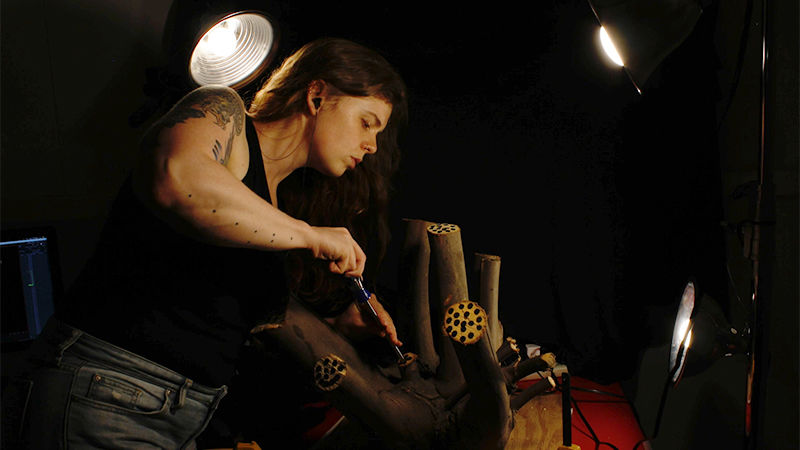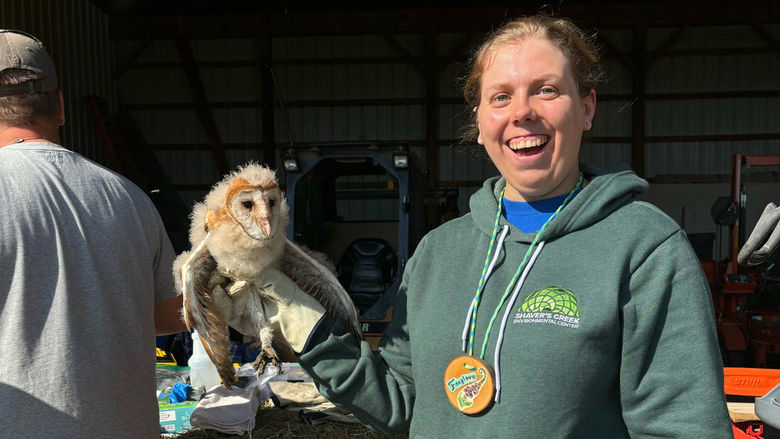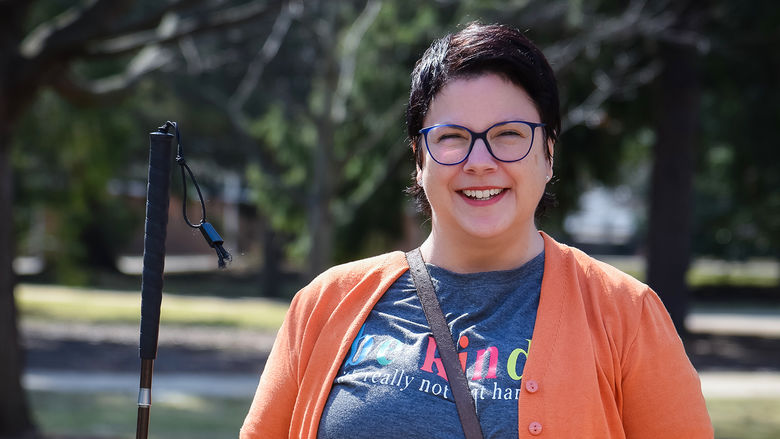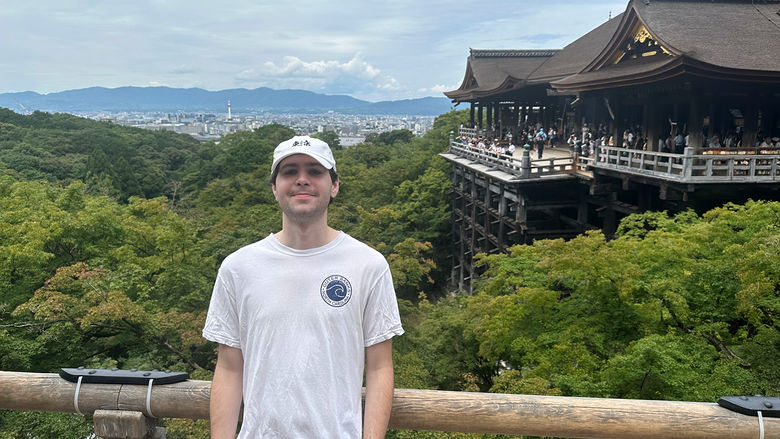

This dialog contains the full navigation menu for this site.

Sarah E. Jenkins enrolled at Penn State Altoona intending to major in engineering, she says, because she “loves environmental science,” and she thought it would bring job security. But one art course changed her trajectory. She could not resist the siren call of the arts and—after a distinguished college experience, including numerous art awards for her paintings and drawings—Jenkins graduated with a bachelor’s degree in visual arts studies and a minor in women’s studies. But she still found a way to embrace the environment.
After earning an MFA at the School of the Museum of Fine Arts, Tufts University, and participating in some artist residencies, Jenkins is now an assistant professor of digital media and animation at Alfred State College – SUNY College of Technology. Animation, she admits, was an art form she had never considered trying. “When I started grad school at Tufts, we were randomly paired with advisers. My adviser was an animator. I was making these experiments, mostly with drawing. My adviser kept saying, ‘you could animate that.’”
Once she took the bait, “something clicked. I fell head over heels for it,” Jenkins says. “There was an absolute delight in seeing my work move. Since my work had been static, it was incredibly exciting to think about it as moving images. Animation added a new dimension and meaning.” She had found a new way to produce her art, which would open opportunities to the ways she creates her works in the studio and outside of it.
In 2018 Jenkins had an artist residency at Stiwdio Maelor in Corris, a “post-industrial, historic slate mining town” in Wales. While exploring the area, she came across a lush site full of slate ruins, stacks of dark grey stone among bright-green moss and ferns, with pale green and white lichens dotting some of the slate. “It was really beautiful,” she says. Then she had a revelation: “you can draw on slate with slate.” Those pieces of slate she saw became canvases—she thought, “I could work within that space.”
Carrying out that inspiration, though, involved a lot of steps. Creating animated works is “incredibly laborious and very intimate. It’s very repetitive work, making many, many small impressions.” First, she thoroughly explored the area, “being open and responding to the environment.” Then she plotted out her work, making “a map in my sketchbook—’rock moss rock rock moss ...’” and so on.
With her plan mapped out, she began the work of drawing and photographing. Technology, of course, is a critical part of animation but in her chosen setting there were limits. “I came with my animation gear—my camera, laptop, and tripod. You need AC power. I didn’t have that option so I had to shoot in short spurts.” In addition to drawing the lines and taking the photographs, Jenkins had to record the audio—“birds singing, waterfall, environmental sounds”—as well as “the foley—the scraping/drawing sounds” of slate on slate. With great attention to detail that the project demanded, she worked “every day for two weeks,” putting her work together and then editing it. The mesmerizing end result, Slate Lines, along with some of her other works, can be viewed on Jenkins's website.
A lot of people would be unable or unwilling to put that much focus into a project, but Jenkins says, “something about the mechanics of stop motion just clicks with me. Stop motion can be incredibly difficult and tedious, but it can also be unexpected and magical. I love the orchestration of it. I love the magic in it. When I’m in a good stop-motion flow, the experience feels meditative.”
Distinguished Professor of Visual Arts Rebecca Strzelec, who taught Jenkins at Penn State Altoona, says, “I’m her biggest fan.” Strzelec reflects on the experience of working with Jenkins “as she developed her senior exhibition, Mirrors and Memories from the Very Young. This impressive body of drawing and painting work reflected on her family, childhood, and themes of domesticity.” Jenkins’s work ethic in particular impressed Strzelec: “Sarah moved through the work with confidence building on her successes and learning from pieces that fell short. She didn’t spend time mourning failure. She would set a less successful piece aside, start on something else, and would later revisit the less successful work. I have seen Sarah return to works and resuscitate them and I have seen her come to terms with pieces that are not salvageable.”
That perseverance and focus in her own work may have its roots in Jenkins’s family history. She grew up in the coalfields of Pennsylvania—her grandfather was a fifth-generation coal miner and her grandmother worked in a textile factory—so she has always been aware of the realities of daily work. “In grad school, I was thinking a lot about labor—especially repetitive labor—and I realized that stop motion, a slow, repetitive process itself, supported my work conceptually. I realized that the process of animation supported the ideas I was thinking about.”
Jenkins credits her time at Penn State Altoona for helping her be more open to animation. “In a way the foundational stuff I learned at Penn State Altoona got me prepared to do animation. I’m still painting, I’m still drawing. It’s all based around the conceptual framework: The concept needs to come before the medium. What matters is that animation was the way to talk about my ideas. Animation was helping me to convey what I was thinking about sewing, about labor.”
Jenkins has pursued her interest in labor in more than just her works of art. She has interviewed ex-coal miners in Pennsylvania and in Wales because “I’m interested in oral histories.” She is also interested in “traditional women’s work.” In sharp contrast to her solitary creations, Jenkins has hosted events she calls Sewing Conversations: “I bring people together to talk and sew. It’s about building community around shared work.” These events take place “in people’s homes or in galleries.” The most recent one was held in pre-pandemic 2020 during the “a nerve is not a nerve but a bundle of fibers” exhibition featuring seven textile artists at Wheaton College.
She clearly has no regrets about the path her career has taken. “Why would you do art?” she asks. “I think learning about art is learning about ideas. It’s learning how to do critical analysis, how to solve problems. That applies to anything in your life.” While she describes her own art as “intimate,” she is fully aware of the impact art has on the world: “Artists are always at the front of social change. They’re asking difficult questions, they’re challenging. What I learned and what I talked about was social change—how can our art make changes, how can our art be used for social justice?”
Jenkins’s next step is a MacDowell residency in Peterborough, New Hampshire, where she will continue her present project, tentatively titled “Disappearing Acts.” She is very much looking forward to the opportunity. “I hope to finish but it depends on how long I’m there. It could be anywhere from two to four weeks. If it’s longer, I could probably start something new.” A MacDowell Fellowship means an opportunity to focus completely on work, she says: “it’s fully funded and they deliver food to you in a basket by the door. It’s like a magical land.” A perfect place to continue her art.


